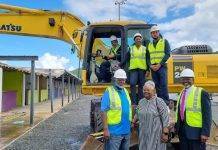Dear Editor,
In the face of an increasingly devastating hurricane season and ongoing environmental degradation, the need for Sint Maarten to adopt sustainable development strategies has never been more urgent. As a resident who has witnessed the transformation of our island, the reckless pace of development has led to the destruction of our natural, cultural, and historical heritage. This approach not only compromises our resilience to climate change but also overlooks the well-being of our communities, communities very vulnerable to the impacts of a changing climate.
The first step towards sustainability is to halt the overbuilding and ecological destruction currently underway. Planned developments threatening our last mangrove strands exemplify the type of short-sighted decision-making that can no longer be afforded. Our natural coastal and terrestrial resources such as mangroves, are not just critical buffers against hurricanes; they also support biodiversity and help in carbon sequestration, making them invaluable to a small island developing state like ours.
Our utilities infrastructure, already struggling under the existing load and still struggling with issues as basic as billing, is a clear signal that our public infrastructure cannot support further large-scale development. This situation underscores the need for a comprehensive carrying capacity study to guide our development choices responsibly.
Effective zoning and implementation of national zoning plans are essential. Our island requires an adaptive zoning strategy that reflects our unique ecological and socio-economic contexts, including stringent protections for sensitive areas. Transitioning our hillside and beach policies into enforceable laws must be prioritized to protect these vulnerable ecosystems from further degradation.
Moreover, it is crucial to establish protected areas for our local fauna and flora. These zones would not only preserve our biodiversity but also provide spaces for our community to reconnect with and appreciate our natural environment.
To ensure a sustainable future, Sint Maarten must also look towards developing a blue and green economy. These sectors focus on ecological conservation and sustainable use of ocean and land resources, providing economic opportunities that do not compromise our environmental health. This approach has been successfully adopted by other regions with similar capacities, showing that sustainable development is not only necessary but also achievable.
Regionally, the perception that Sint Maarten, supposedly supported by the Netherlands, should be a leader in sustainable practices is met with disbelief when the reality of our situation is revealed. We must dispel this notion by taking proactive steps ourselves, especially in light of the current political climate in the Netherlands which suggests that we should not expect much support from that quarter.
Our commitment to sustainability must include rigorous environmental and social impact assessments for all developments. These assessments are critical in preventing the destruction of our historical, cultural, and natural resources and in ensuring that our communities are not adversely affected by development projects.
Sint Maarten stands at a critical juncture, and the choice is clear. We must reject unsustainable practices that have led to environmental degradation and embrace a development model that ensures environmental resilience, economic viability, and social equity. The time to act is now, lest we face the irreversible consequences of inaction in the face of climatic adversity.
Tadzio Bervoets




























